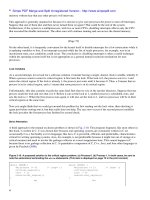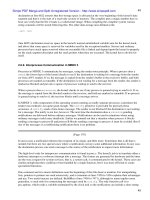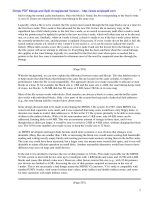Design management managing design strategy, process and implementation, 2nd edition
Bạn đang xem bản rút gọn của tài liệu. Xem và tải ngay bản đầy đủ của tài liệu tại đây (14.24 MB, 365 trang )
Prologue
Introduction
Context
What is Design Management?
Why is Design Management Important?
Design Management Timeline
PART ONE
Managing the Design Strategy
KNOWLEDGE
Identifying Opportunities for Design
Understanding the Audience and Market
Interpreting Client and Customer Needs
Auditing the Use of Design
Establishing the Design Strategy
Promoting and Selling the Design Strategy
Planning for Long-term Growth
PRACTICE
Case Study: The Argus®3 Thermal-Imaging Camera
Case Study: Camper
Interview: Dr. Chris H. Luebkeman, Arup Group
Interview: Keiko Uchida, Keiko Uchida Collection
KEY SKILLS
Managing Client Relations
Guiding Design Decisions
Developing Good Working Relationships
Verbal Communication
Key Skills Exercises
PART TWO
Managing the Design Process
KNOWLEDGE
Giving Form to Business Strategy
Increasing Awareness with Design
Expressing the Brand through Design
Initiating Design Projects
Design Methods
Design Processes
Competitive Advantage through Design
PRACTICE
Case Study:
Kajima Design Europe for JVC
Case Study: The Honda Zoomer
Interview: Fabio Issao, Mandalah Conscious Innovation
Interview: Chloe Martin and Rosie Frost, The Innovation Collective
KEY SKILLS
Managing Creative Teams
Facilitating the Design Process
Developing Collaborative Cultures
Visual Communication
Key Skills Exercises
PART THREE
Managing the Design Implementation
KNOWLEDGE
The Project Management Process
Project Management in Practice
Social and Environmental Responsibilities
Design Policies, Procedures and Guidelines
Translating Global Design into Local Design
Measuring the Success of Design
Reviewing and Revising the Design Strategy
PRACTICE
Case Study: Sprunk-Jansen and Ping-Pong Design
Case Study: The Silken Group
Interview: Brian Gillespie, Continuum
Interview: Colette Liebenberg, Colette Liebenberg Design
KEY SKILLS
Management and Leadership
Leadership and Advocating Design
Written Communication
Key Skills Exercises
Appendix
18 Views on Design Management
Further Resources
Glossary
Additional Credits
Acknowledgements
PROLOGUE
Introduction
Design management is about the management of design.
In its most basic sense, design management is about managing design projects; projects paid for by a
client, a business or an organization, and carried out by a designer, a design team or a design
consultancy. For some, this is where design management stops, but for others, it is more than just a
form of project management. Design management as an approach has a myriad of other uses.
Design describes both the process of making things (designing), and the product of this process (a
design). Design plays a key role in shaping the world and generating new products, systems and
services in response to numerous market conditions and user needs. According to a recent Intellectual
Property Office (IPO) report, there are 315,000 designers working in the United Kingdom alone, and
another 590,000 working in design-related employment.
Can design be used to add more value to business? What roles can design play in society and
politics? Designers are often labeled as ‘creatives’, but they are just as likely to employ analytical
skills when faced with a problem. Similarly, public and private sector managers tend to be quite
analytical, but they are just as likely to adopt a creative approach when seeking a business solution.
Designers and managers both exhibit the ability to be analytical and creative, but in different ways,
using different tools, and with different outcomes. The stereotypes of designers and managers overlysimplifies the complexity of design management (and of people), and this book extends beyond these
simple generalizations. Design is intrinsically linked to business, in a way that can both add and
create value for organizations and the wider context as a whole.
Beyond the superficialities of the style and aesthetics debate, and beyond the simplistic view of
designers and managers, there are opportunities for individuals at various stages of their career,
working in a wide range of organizations, and at different project stages, to promote and utilize the
value of design. Design management is not a clearly defined vocation, career path or academic
subject area; no two ‘design managers’ will have the same background, training or experience in how
they got to the position of being the decision-maker about the management of design. Design
management can be a strategic leadership role, one that requires explaining, inspiring, persuading and
demonstrating how design can positively contribute to an organization in many different ways. It can
also be a tactical managerial role, where the focus is on delivering a specific project, task or
outcome.
The aim of this book is to promote a clearer understanding of design’s role in business and the
broader context, and the importance of design as a way of creating value in any organization. The
book is a guide for students of design, design management, marketing, media communications and
business studies, and for anyone involved in the management of design and creativity.
The book begins with a contextual overview of design management, which is followed by three
‘parts’. These parts fully explore the management of the design strategy, process and implementation
respectively.
Part One: Managing the Design Strategy looks at the first stage of design management, where
design projects and initiatives are conceived. The focus of this stage is on identifying and creating the
conditions in which design projects and ideas can be proposed, commissioned and promoted. At this
stage, design management engages design thinking in an organization’s strategy, identifying the
opportunities for design, interpreting the needs of its customers, and looking at how design
contributes to the overall business.
Once an organization has made the decision to invoke a design strategy, design management deals
with the establishment and promotion of it, securing the support and commitment of the stakeholders
in the business, and planning for long-term growth – not just immediate and short-term gains.
Part One investigates the skills required in managing client relations and guiding design decisions,
building relationships, and developing the necessary verbal communications skills to achieve the
effective exchange of ideas and information.
This stage is about how those responsible for the management of design can inspire design thinking,
projects and possibilities.
Part Two: Managing the Design Process looks at the second stage of design management, where
design projects and agendas are developed. The focus of this stage is on demonstrating how strategy
can be made visible and tangible through design. At this point, design management is about how
design can be used to craft the presence and experience of an organization, and in doing so influence
how the organization and its brand are expressed and perceived. To help identify the management
challenges that will be faced when initiating design projects, models from a range of design-related
processes and disciplines are provided. Theoretical models can never provide an instant solution, as
they are abstract representations of real-life situations, and no single model will fit all solutions.
These models are intended as starting points from which to develop project-specific approaches,
ones which enable an organization to explore competitive advantage through design.
Part Two investigates the skills that are required to effectively manage creative teams, facilitate the
design process, lead designers, develop a culture of collaboration and develop solid visual
communication skills in order to make thoughts and ideas presentable.
This stage is about how those responsible for the management of design can lead design agendas,
projects and processes.
Part Three: Managing the Design Implementation looks at the stage of design management where
design projects and outcomes are delivered. The focus of this stage is the process and practice of
managing projects, including the decision-making involved in specifying design materials, working
relationships and ethical responsibilities. Once a design project has been completed, the delivery of
it can entail further stages of design management, such as developing design guidelines and manuals,
the maintenance and evolution of the design, and translating design solutions for the global context.
Evaluating the success of the design project allows positive feedback to inform and promote the
effective use of design.
Part Three investigates the skills required when managing creative projects, such as leading and
advocating design project successes, developing good written communication skills and
understanding the differences between the management and the leadership of design agendas.
This stage is about how those responsible for the management of design can manage design agendas,
projects and people.
CONTEXT
The role of design, and its management, in business, society, culture
and the environment has a rich and active history. This section of the
book provides an introduction to some of the key debates and
definitions of design management, and reasons behind their
importance today. It also provides an overview of the background and
origins of design management in the form of a timeline.
CONTEXT
What is Design Management?
There is no single, universally agreed definition of the term ‘design management’, just as there is no
single agreed definition of ‘design’, or in fact of ‘business’. When looking at the nature of ‘design’,
the word itself is both a noun (an outcome), and a verb (an activity). The outcome of a design project
can be seen in the products, services, interiors, buildings and digital media that we come into contact
with daily. The management of these design projects is only one aspect of design management. The
activity of designing is a people-centered, problem-solving process, which also needs to be managed
and therefore is another facet of design management.
The term ‘business’, when used in the context of design and business, can become a container for all
kinds of non-design activities such as marketing, finance, strategic planning and operational activities.
In the area of design management a wide variety of perspectives exist that reflect the rich array of
individuals, professions and contexts involved, such as academia, the public or private sectors,
business and industry, the design profession, public services and governmental bodies. Indeed, the
lack of consensus on both the scope and substance of the design management discipline has ensured
ongoing, rich debate about its continual evolution.
Topalian has stated that within an organization, design management consists of managing all aspects
of design at two different levels: the corporate level and the project level. Topalian also believes that
‘design management development needs to broaden the participants’ experience of design problems
and the range of project and corporate circumstances within which they have to be solved’ (2003).
Gorb has defined design management as ‘the effective deployment by line managers of the design
resource available to the organization in the pursuance of its corporate objectives’ (1990). This
definition suggests that the subject is therefore directly concerned with the organizational place of
design, and with the identification of those design disciplines that are relevant to the resolution of key
management issues, as well as what training managers need to use design effectively. Hollins
describes design management as ‘the organization of the processes for developing new products and
services’ (2002), and for Cooper and Press, being a design manager is about ‘the response of
individuals to the needs of their business and the contribution they can make to enable design to be
used effectively’ (1995).
For Raymond Turner, design management success in business is not so much about practices, as about
attitudes and behavior (2013).
As a job description, the design manager has the role of managing design. What exactly this entails
will vary from organization to organization, and the person responsible for managing design might be
called a ‘brand manager’, a ‘project manager’, an ‘account director’, a ‘design consultant’ or an
‘advertising planner’. The important aspects of managing design, irrespective of the job title, are
about understanding the strategic goals of an organization and how design can play a part, and
effectively putting in place the ways and means, the tools and methods, the teams and planning
requirements and the passion and enthusiasm, to achieve these goals as successful outcomes.
There is growing awareness within many organizations that design is a valuable means to achieve
strategic goals and objectives. There is also an increasing desire to understand the design tools (the
methods and ways of thinking that the design process brings), and the design planning and
implementation, which effective project management of design brings. More recently, design is being
valued as an enabler of innovation and collaborative (as well as competitive) advantage.
Whirlpool is the world’s leading manufacturer and marketer of major home appliances. Whirlpool introduced their revolutionary new
clothes revitalizer in response to five of the latest emerging trends identified by an expert panel of international style leaders from the
world of fashion and interior design. Understanding the impact of these trends on consumer needs and Whirlpool’s own business
objectives drove the design of ‘prêt-à-porter’, a fast, easy and practical way to keep clothes smelling fresh and looking great.
Image courtesy of Whirlpool Corporation.
The W. W. Stool, designed in 1992 by Philippe Starck for a Wim Wenders film, is produced in a small series by Vitra. The stool ignores
functional constraints, allowing Starck’s imagination to have full reign. It is more like a sculpture, which can be used as a stool or standing
support, rather than an item of purely functional furniture.
Image courtesy of Vitra, (photograph: Hans Hansen).
The Heart Cone Chair (1959), from the Verner Panton-designed collection at Vitra. For all its extravagance, it is a comfortable club
chair for everyday use.
Image courtesy of Vitra, (photograph: Marc Eggimann).
Table 1: The Key Categories of Design
‘Design management is rooted in the shift from a hierarchical model of
management to a flat and flexible organizational model, which
encourages individual initiative, independence and risk taking.
Designers feel at ease with the new, more informal model of
management. The new model is based on concepts like customer-driven
management, project-based management, and total quality
management, which all deal with design.’
Brigitte Borja de Mozota.
QUESTION FOR DISCUSSION: Is it possible, or desirable, to create a single, standard
definition of design management that can be applied to all areas of design, business and society?
Understanding the context in which design operates helps design managers to identify opportunities for new creative projects, processes
and enterprises, and plan for the resources needed. It also helps other decision-makers understand what they need to contribute, and how
these projects support their goals.
Inside an organization, design typically exists as an in-house team working alongside or embedded within other functional business units.
Design can also exist outside the organization as a consultancy or agency.
Moleskine produce the legendary notebooks popularized by many famous artists and writers including Henri Matisse and Ernest
Hemingway. Planning a new generation of products for a new generation of consumers means that Moleskine can build on their
successful traditions, and continue to develop and launch new ranges. Typically, when launching new product ranges, many companies,
including Moleskine, involve a number of decision-making representatives from areas such as design, marketing, distribution and sales.
Image courtesy of Moleskine.
CONTEXT
Why is Design Management Important?
The economic importance of design, and its use as a communication and strategic business tool, has
reinforced the status of design management and placed the true potential of design high up on
organizational agendas. Equally, design is aiding the development and innovation of social,
environmental, technological and cultural processes within enterprises of all kinds.
For students, the changing roles and challenges of design mean there are new demands made on those
wanting to build careers in design and the creative industries. Design is inextricably linked to the way
in which society, the environment and business interact, and as a result today’s organizations are
approaching design in a more ‘managed’ way. In order to have a successful, long-term career in
design, it is necessary to understand how and where design sits within a wider context, and how the
true potential of design can be engaged and professionally managed as a tool for innovation and
change.
Within an organization, design can affect management on many different levels and in many different
ways. Design can be active on strategic, tactical or operational levels, in setting long-term goals and
in day-to-day decision-making. Design is a function, a resource and a way of thinking within
organizations and one that can be active in the strategic thinking, the development processes and,
crucially, the implementation of projects, systems and services; the ways in which an organization
connects and collaborates with its customers and stakeholders. By becoming more in tune with the
commercial pressures of industry, and by understanding how to use design more effectively, graduates
will be at a distinct advantage in making professional design contributions, whether they are forming
a start-up or joining a commercial business enterprise, the public sector, or a non-profit organization.
In the wider context, there is an ongoing shift from industrial economies to knowledge economies and
creative economies, from manufacturing-based processes to information-based and idea-based
processes, and from international trade agreements and restrictions to increasingly competitive
market challenges from emerging and expanding economies worldwide. In terms of design, this
impact is apparent in the evolution of design debates: from ‘style and aesthetics’ to a means of
improving products, services, innovation processes and operational efficiencies. The focus of design
is now on improving customer services and experiences, and creating better efficiencies and waste
reduction strategies in both the private and public sectors. It is inevitable that how design is managed
in this shifting context will also change.
The practice of design management is evident across a range of disciplines such as product and
service design, fashion, architecture, media, entertainment, advertising, digital media and games
design. In addition, how design is perceived and utilized in the realms of business, engineering,
technology and the creative disciplines varies enormously, and so, different approaches to how
design is managed are required in each context.
Within an organization, design management is present in the brand communications, the product and
service designs, the corporate buildings and retail environments, and the digital interfaces and
advertising campaigns of each enterprise. Externally, design management can respond to the growing
pressure for organizations to address government legislation, regulations, policies and politics, and
changing attitudes around the world to the management of local and global resources as well as
people.
All of these internal and external demands, from organizational goals and customer requirements to
social and environmental responsibilities, need to be taken into account in the management of design,
and all of these aspects need to be managed in order to maximize the time, money and resources that
an organization invests in design in order to present itself favorably to both current and potential
consumer markets.
Design is active at three levels in any organization: strategic, tactical and operational. At the strategic level, the overall policies, missions
and agendas are defined – and it is to these agendas that design must connect. At the tactical level, the teams, processes and systems of
specific business units or functions come into play. At the operational level, design manifests itself in the physical and tangible products,
services and experiences – the implementation of projects and processes the customer can actually ‘touch’.
Source: Adapted from Sean Blair, ProMeet.
Managers of design often have to transcend roles and adapt to different situations. The design leader sets the vision for how design could
be used within an organization, selling the vision to, and gaining buy-in from, key stakeholders and decision-makers. The design manager
ensures the design processes, procedures and internal functions are adding value to the organization, through a defined design team or
through the internal resourcing of design thinking into and across a range of business units and projects. The designer helps unlock the
potential of a proposal, and crafts and delivers the solution, to brief, on time and within budget, to satisfy client and customer needs.
Source: Mike Crump, Honour Branding Ltd.
‘Worldwide, many countries are beginning to address the challenge of
a world that is becoming vastly more competitive. Technology that is
not carried through into improved systems or successful products is an
opportunity wasted; enterprise that fails to be sufficiently creative is
simply pouring more energy into prolonging yesterday’s ideas.
Creativity, properly employed, carefully evaluated, skillfully managed
and soundly implemented, is a key to future business success and
national prosperity.’
Sir George Cox.
According to Powell (2004), the importance of design management is growing in four fundamental
ways:
1. As businesses of all kinds deepen their understanding of the role of design in innovation, they will
look to design management as a powerful resource for innovations that will effectively differentiate
their business and build sustainable competitive advantages.
2. As people continue to find increasing choices in the marketplace, and become more determined to
improve the quality of their lives, they will demand more of what only the effective management of
design can provide in good design.
3. The shift in attitude from design management to managing for design will unleash the potential of
design.
4. The increasingly important role design will play in building a bridge between the fundamental
economic and cultural aspects of individual nations and the world will open doors for design to make
a key contribution to healthy, balanced societies worldwide.
Clearly, there is growing recognition of the potential benefits of design management. However, it is
also emerging as a driving force in social policy and environmental regulations, and in educational
and government initiatives. An independent report sponsored by Capita, the Design Council and the
AHRC calls for a greater use of design thinking in building and delivering public services, to ensure
they are made both more responsive to users’ needs and more cost effective (2013).
The Cox Review of Creativity in Business was commissioned by the British Government in 2005 to
investigate ways in which creative skills might be exploited more fully, and described the valuable
connection that exists between creativity, innovation and design.
Creativity: is the generation of new ideas. Either new ways of looking at existing problems, or the
discovery of new opportunities.
Innovation: is the exploitation of new ideas. It is the process that carries a concept through to new
products, services, or ways of operating the business.
Design: is what links creativity and innovation. It shapes ideas so that they become practical and
attractive propositions for users or customers.
Design has become a critical and strategic function and methodology in today’s evolving
organizations, and the need for the knowledge, the ability and the skills to lead, plan and manage for
design is becoming more important.
Table 2: Design Statistics in the UK
QUESTION FOR DISCUSSION: What other emerging trends can be identified in order to begin
to think about the role of design in business, society, technology, the environment and politics in
the future?
Design can help not only to achieve business objectives, but cultural and social agendas too, especially in the non-profit and public
sectors. Recognizing a need for alternative energy sources amongst the world’s poorest communities, Freeplay Energy is committed to
providing innovative and practical energy solutions to ensure sustained access to information via the radio. The foundation continually
searches for new applications for Freeplay’s patented wind-up and solar-powered technology. The ‘Encore Player’ is a solar and
dynamo powered multi-band radio, MP3 player and recorder designed for off-grid communities. It has been designed and engineered for
the humanitarian sector and is used by educational programs, listening groups and other programs where training and information are
crucial.
Image courtesy of the Freeplay Energy Ltd.
Industrial Society 1830–1944
1759 Josiah Wedgwood, a creative and business thinker, sets up his own pottery enterprise and produces new, inexpensive and
beautiful tableware.
1830 Inventions such as the steam engine and the weaving machine necessitate the reorganization of industry. Manufacturing,
mass production, utility and efficiency begin to replace handcrafts.
1832 The National Gallery opens in London, exhibiting fine arts to educate manufacturers and encourage good taste in consumers.
Conceived as an aid to the manufacturer in his struggle with foreign competitors, the gallery effectively promotes the idea of an
‘industrial’ design.
1833 Isambard Kingdom Brunel appointed as chief engineer of the Great Western Railway, establishing him as one of the world’s
leading engineers.
1851 The Great Exhibition of the industries of all nations asserted Britain’s world leadership in manufacturing and the ‘useful’ arts,
and celebrated the fusion of science, art and design.
1861 William Morris, a British craftsman and designer, sought distinction between the work of the hand and the product of the
machine, and in doing so took art out of the academies and into the design of everyday objects.
1869 Charles Eastlake publishes Hints on Household Taste, which claimed to be the first publication on design written ‘in a
manner sufficiently practical and familiar to ensure the attention of the general public’.
1877 Christopher Dresser appointed as art adviser to Huskin & Heath, a silver manufacturing and industrial production firm and
supplier of novelties and luxury goods. Dresser’s role was to help provide a new creative direction for the firm.
1887 AEG (Allegmeine ElektrizitatsGesellschaft) established. AEG rapidly gains a reputation for advanced management and for
design patronage.
1907 Peter Behrens, the first designer for industry, appointed as design adviser to AEG, consulting on buildings, products and
graphics, and effectively creating the first corporate identity.









